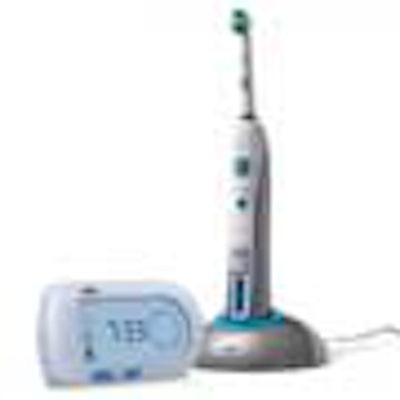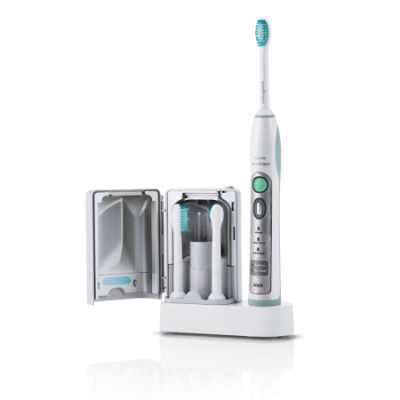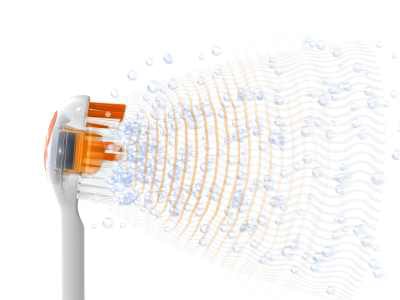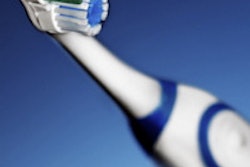
Americans love gadgets, so it's no surprise that power toothbrushes are gaining in popularity here. But this year, as the leading manufacturers roll out new models, two questions linger: Is power really better than manual? And do the new power brushes beat the old ones?
The answer to the first question, according to some of the world's leading experts, is (an extremely qualified) yes. "I think the power brushes are significantly better than manual toothbrushes," says Samuel Yankell, Ph.D., R.D.H., a former University of Pennsylvania professor who now tests toothbrushes as a private consultant. But the advantages are small, Dr. Yankell and other brush testers admit, and the brusher matters more than the brush.
As for which brand is best, the most convincing study to date favored brushes whose heads move in "rotation oscillation" which means they spin one direction then spin the other. It's a category dominated by Oral-B.
 |
| The Philips Sonicare FlexCare comes with a UV sterilizer. |
That study was done before a new company, Ultreo, leapt into the field this year claiming superior results for the ultrasonic waves its brush produces. Not to be outdone, Oral-B released its Triumph with SmartGuide ProfessionalCare 9910, the first toothbrush with a detached monitor that communicates wirelessly with the brush to tell you how well you're brushing. Philips, meanwhile, has introduced the Sonicare FlexCare with multiple speeds and a UV chamber intended to sterilize brush heads between uses.
The new offerings add to a diverse selection. In addition to manual brushes of multiple designs, Amazon alone offers a dozen power brushes with prices ranging from $16.99 to $179.99.
 |
| Makers of the Ultreo toothbrush claim its bubbles clean what bristles can't. |
Demand for the devices is on the rise. Power toothbrushes first hit the market in the 1960s in a wave that animated everything from carving knives to garbage cans. Since then, automated brands have been edging manual brushes out of U.S. medicine cabinets; currently about 30 percent of American consumers use power brushes, says Sharon Ross director of marketing for Ultreo. While Philips and Oral-B dominate the market, Ultreo is determined to seize a share with its patented technology.
What's the difference?
So what sets one apart from the other? Bells and whistles aside, the leading makers all point to scientific evidence that demonstrates their brushes do the best job when it comes to removing the nasty stuff from teeth. Ultreo boasts that its power brush uses a transducer to sends sound waves through the foam in your mouth. Tiny bubbles jiggle into places that mere bristles can't reach, scrubbing them clean, says Ross. It's the same principle behind professional ultrasonic cleaning equipment.
By contrast, the competing Sonicare brushes don't actually use sound waves to clean teeth, she says. Putting sonic in the name "was a great marketing name because it made people think it was doing something more than moving fast."
But Philips claims its bubbles are just as jiggly as anyone else's. Ultreo's might show more action in the lab, says Philips spokesperson Shannon Jenest, but not in the mouth. "We have specific research against that."
For its part, Oral-B doesn't think any of the sonic claims hold water. You can rev up your transducer all you want but "nothing actually happens," says spokesperson Avery Schlicher. In fact, her company has taken Ultreo to court for saying Oral-B is inferior. Naturally, Ultreo has countersued.
Children, please!
The fact is, just about any toothbrush will do a decent job cleaning teeth, brush experts say. Even power brush enthusiast Dr. Yankell agrees that diligence is more important than technology. "You have to get in there and get rid of plaque. If you're conscientious, you could do it with your finger."
The lab and the mouth
All three companies can show you lots of laboratory studies proving that their brushes scrub teeth squeaky clean. But clinical trials are a different matter. These have focused on two outcomes: reducing plaque and reducing gingivitis. Over the decades, they came up with a wide range of conflicting results.
The debate got so muddled that the Cochrane Collaboration stepped in. This international group of researchers has developed standards for compiling data from multiple trials into one big meta-analysis. For a 2003 review of power toothbrush effectiveness, Cochrane researchers found 42 studies -- with a total of 3,855 patients -- that were well-enough conducted to produce meaningful results.
The bottom line? Most of the power toothbrushes had little or no advantage over manual brushes. The main exception was brushes that used a rotation oscillation motion. In three months or less, brushes with this type of motion reduced plaque by 11 percent more than manual brushes on the Quigley Hein index and gingivitis by 6 percent more on the Löe and Silness index. These power brushes also reduced bleeding on probing by 17 percent over a period exceeding three months on the Ainamo Bay index.
But when the Cochrane researchers reviewed their data for a 2005 update, they raised questions about their own findings' statistical significance.
And the study fell short of standards set by one of the most important arbiters of dental quality, the American Dental Association (ADA). "The ADA hasn't seen data to convince us that power toothbrushes are better than manual toothbrushes," says Clifford Whall, Ph.D., the director of the organization's Acceptance Program. In order to satisfy the ADA of its superiority, a toothbrush would have to reduce gingivitis by 15 percent or more in comparison to manual brushes that meet the minimum ADA standards, he said.
Nor has anyone proven that any power brush -- oscillating or otherwise -- makes a difference after the first few months. In fact, the Cochrane researchers pointed out, it's not even certain that gingivitis and plaque lead to destructive periodontal disease. Then, too, the power toothbrushes were compared to the old-fashioned ADA standard brush which (according to claims by some of the same companies) isn't as good as newfangled manual brushes with extra-soft crossed bristles.
Finally, says Dr. Yankell, patients don't always stick with their power brushes anyway. "With long-term use, interest goes down and usage goes down," he says. For example, "if the batteries wear out or pop out, patients may stop using them." One study showed that a third of power toothbrush purchasers abandoned them after three years.
So what convinces Dr. Yankell that power brushes are better? The lack of long-term clinical evidence doesn't completely negate the importance of laboratory evidence. "In the lab, there have been some very good studies," he says. "We have been able to consistently show that head design is important in cleaning teeth. New head designs are coming out all the time and I think it's very important."
But more important than head shape, movement, or how it makes bubbles dance, is whether the patient uses it properly. One of the chief advantages of the power brushes, points out Yan-Fang Ren, D.D.S., Ph.D., M.P.H., a brush tester and assistant professor of dentistry at the University of Rochester, is that they often come with timers. The average person only brushes for about 45 seconds instead of the recommended two minutes. The better brushes let you know when you've been at it long enough. The FlexCare, Ultreo and Triumph units will even announce when it's time to brush a different quadrant; the Triumph also tells you if you're brushing too hard.
So which brush should you recommend to patients? It depends on the patient. Richard Niederman, D.M.D, a periodontist who directs the DSM-Forsyth Center for Evidence-Based Dentistry in Boston, was impressed by the evidence for Oral-B power brushes in the Cochrane study. But he thinks the expense of the brushes is an important consideration. "I give out power toothbrushes as gifts," he says. "I don't recommend them to everyone."
Some people fit a power brush profile. "If a patient comes in with red and bleeding gums, but they brush every day," says Dr. Niederman, "I'm going to recommend a power toothbrush. But if they brush once a year and their gums and teeth look great, I won't." Other patients who might especially benefit from power brushes are teenagers and anyone with braces.
To that list, Dr. Yankell adds people with poor manual dexterity. He advises dentists to watch how their patients brush, perhaps even giving them three or four brushes to try in the office. The ultimate criterion: "You have to keep your patients interested in brushing."



















